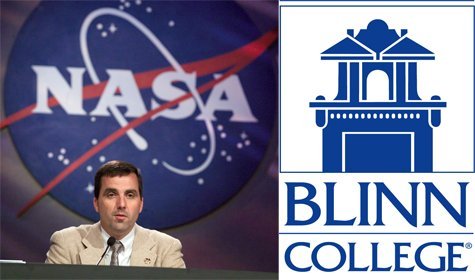To many college students, math and science can feel like rocket science. But after 25 years as one of NASA’s leading rocket scientists, Paul Hill is uniquely prepared to help them on their path to high-demand careers.
Blinn has announced that Hill, director of Mission Operations at the NASA Lyndon B. Johnson Space Center since 2007, will serve as a lecturer at the College as part of an interagency personnel agreement between Blinn and NASA.
Hill will work primarily with Blinn’s Division of Science, Engineering & Mathematics on the Blinn-Bryan campus. In addition to his duties as a member of the faculty, Hill will utilize his unique experiences to participate in curriculum development and conduct space-related outreach to highlight NASA programs and promote science, technology, engineering and math (STEM) education.
“We are very excited to bring someone with Paul’s incredible expertise and leadership skills into the classroom and into contact with our students,” said Sylvia McMullen, president of Brazos County campuses. “We look forward to working with him as we expand our STEM curriculum and prepare students for high-demand jobs in science, engineering and mathematics.”
A third-generation graduate of Texas A&M University, Hill earned his Bachelor of Science and Master of Science degrees in aerospace engineering. Following graduation, he worked in military satellite operations in the Air Force. Attaining the rank of captain, Hill served as an aerodynamics and aircraft performance instructor.
Hill began working for NASA in 1990 as a space station and space shuttle operations engineer, where he was a leader in the development of Space Station Freedom assembly operations and participated in every formal space station design review.
In 1996, he was appointed space shuttle and international space station flight director, and was responsible for the safe conduct of manned space flight missions, leading the team in flight preparation and execution from Mission Control. As flight director, he supported 24 shuttle and international space station missions.
Hill led the Space Shuttle Columbia accident investigation team responsible for detecting and locating early debris during re-entry, obtaining and analyzing all data collected by government agency sensors during entry and coordinating radar testing with the Air Force Research Laboratory. Most notably, he led the teams that developed methods to detect and repair shuttle damage in orbit and then was the Flight Director who led shuttle’s return-to-flight.
As an executive, Hill managed a $650 million, 3,000-employee enterprise that included Mission Control. While continuing space operations, he led initiatives that cut Mission Control’s operations costs in half and increased capability. He developed groundbreaking partnerships with commercial spacecraft manufacturers that resulted in NASA’s Mission Control providing commercial service to this new industry, and pioneered additional commercial partnerships to share aerospace-related facilities with other industries, further reducing NASA’s costs of doing business.
Hill has an unprecedented track record for evolving an established large organization into an aligned, high-performing senior leadership team, and has transformed a government organization into a competitive, customer- and market-focused enterprise by embracing corporate business rigor in financial and project management practices.
Blinn’s Division of Science, Engineering & Mathematics offers courses in biology, chemistry, geology, mathematics, pre-engineering and physics, and offers extracurricular programs such as the Science Club. For more information, visit www.blinn.edu.

